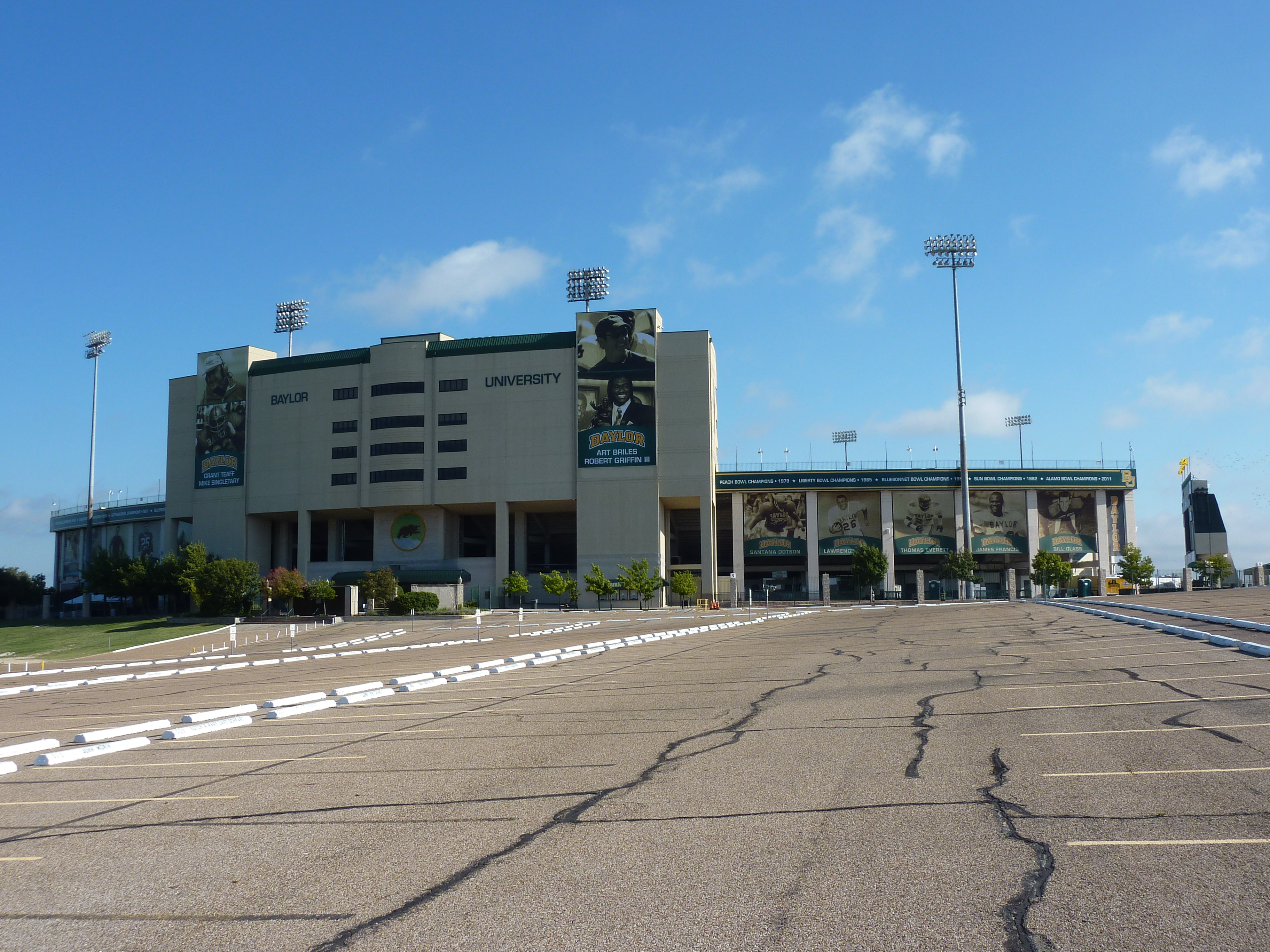Floyd Casey Stadium on:
[Wikipedia]
[Google]
[Amazon]
Floyd Casey Stadium was a stadium in 

Waco, Texas
Waco ( ) is the county seat of McLennan County, Texas, United States. It is situated along the Brazos River and I-35, halfway between Dallas and Austin. The city had a 2020 population of 138,486, making it the 22nd-most populous city in the st ...
. The stadium was used for 64 seasons before being replaced by McLane Stadium
McLane Stadium is an American football stadium in Waco, Texas owned and operated by Baylor University. Originally named "Baylor Stadium", the facility's name was changed to "McLane Stadium" in December 2013 to honor Baylor alumnus and business m ...
in 2014. It was primarily used for football, and was the home field of the Baylor Bears
The Baylor Bears are the athletic teams that represent Baylor University. The teams participate in Division I of the National Collegiate Athletic Association (NCAA) as one of only two private school members of the Big 12 Conference. Prior to j ...
. The stadium, located about four miles from the Baylor University
Baylor University is a private Baptist Christian research university in Waco, Texas. Baylor was chartered in 1845 by the last Congress of the Republic of Texas. Baylor is the oldest continuously operating university in Texas and one of the fir ...
campus, cost $1.8 million to build and sat 50,000 people. Originally named Baylor Stadium, it opened in 1950 with a Baylor game against the Houston Cougars
The Houston Cougars are the athletic teams representing the University of Houston. Informally, the Houston Cougars have also been referred to as the Coogs, UH, or simply Houston. Houston's nickname was suggested by early physical education instr ...
. On December 7, 2013, Baylor played its last game in the stadium, against the Texas Longhorns
The Texas Longhorns are the athletic teams representing the University of Texas at Austin. The teams are sometimes referred to as the Horns and take their name from Longhorn cattle that were an important part of the development of Texas, and ...
, where the attendance record of 51,728 was established. Baylor won 19 of its final 20 games played at the stadium.
Originally known as Baylor Stadium, the stadium was renamed at halftime of the November 5, 1988 homecoming game when it was renamed for Floyd Casey by his son, university trustee and longtime booster Carl B. Casey of Dallas, who gave US$
The United States dollar (symbol: $; code: USD; also abbreviated US$ or U.S. Dollar, to distinguish it from other dollar-denominated currencies; referred to as the dollar, U.S. dollar, American dollar, or colloquially buck) is the official ...
5 million towards an $8 million stadium renovation project.
The stadium was renovated several times. Turf was first introduced to the stadium in 1972. Then in 1998, the stadium installed SportGrass, a leading artificial grass surface. In 2005, it underwent massive renovations to extend the Grant Teaff Plaza in honor of former head coach Grant Teaff
Grant Garland Teaff (; born November 12, 1933) is a former American football player and coach. He served as the head coach at McMurry University (1960–1965), Angelo State University (1969–1971), and Baylor University (1972–1992), compiling ...
. The extended plaza created much-needed updates to the stadium's façade.
The stadium was an elongated oval shape, running southeast-northwest, with large grandstands on the sidelines. The south end zone was cleared, with athletic marks painted on the ground and the large LED scoreboard behind it. (Prior to the creation of the current athletic marks, the area was painted gold, with "BAYLOR" painted in large green block letters.) In 2004, a large tarp was installed that covered the south end zone and could be removed when ticket demand necessitated it. With the tarp in place seating capacity
Seating capacity is the number of people who can be seated in a specific space, in terms of both the physical space available, and limitations set by law. Seating capacity can be used in the description of anything ranging from an automobile that ...
was reduced to 47,000. The north end zone had seating in front of the Carl & Thelma Casey Athletic Center, site of the football offices, training facilities, and stadium field house.
Prior to the building of the stadium, the Baylor football team played at Carroll Field
Carroll Field was owned by Baylor University; the Baylor Bears football program played games there from 1906 to 1925, and from 1930 to 1935. Following the construction of the Carroll Science Building in 1902, the field was located between the b ...
, an on-campus field last used in 1935, and Waco's Municipal Stadium on Dutton Avenue.
In the spring of 2012, Baylor regents approved a new on-campus stadium to be built on the Brazos River
The Brazos River ( , ), called the ''Río de los Brazos de Dios'' (translated as "The River of the Arms of God") by early Spanish explorers, is the 11th-longest river in the United States at from its headwater source at the head of Blackwater D ...
adjacent to Interstate 35
Interstate 35 (I-35) is a major Interstate Highway in the central United States. As with most primary Interstates that end in a five, it is a major cross-country, north–south route. It stretches from Laredo, Texas, near the Mexican border ...
.
The demolition of the stadium was completed on May 14, 2016.
College football attendance records
References
{{Baylor Bears football navbox Sports venues completed in 1950 Sports venues demolished in 2016 Baylor Bears football venues Sports venues in Waco, Texas American football venues in Texas 1950 establishments in Texas 2016 disestablishments in Texas Demolished sports venues in Texas Defunct college football venues